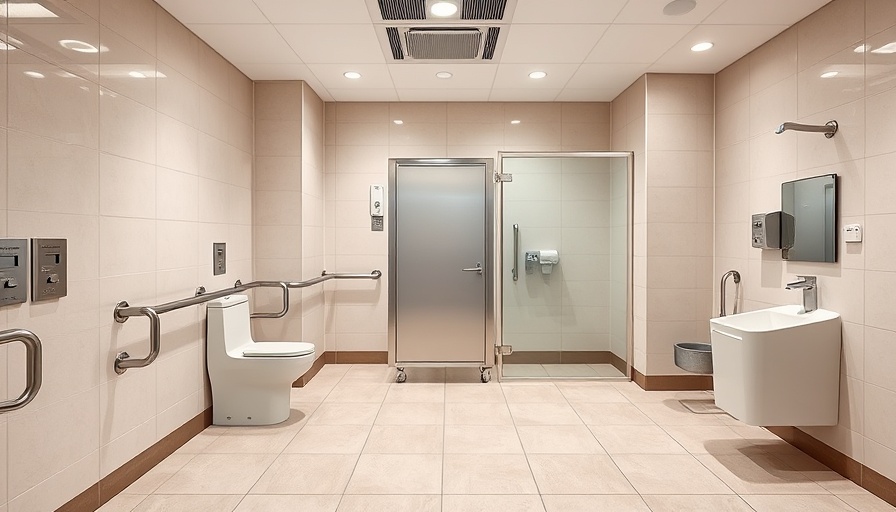
Understanding Accessibility: More Than a Requirement
Creating a welcoming environment for all individuals transcends merely being a good business practice; it’s a legal obligation as outlined by the Americans with Disabilities Act (ADA) and various state regulations. As a result, understanding compliance around handicap-accessible restrooms is crucial for both businesses and public facilities. In many communities, inclusivity is no longer just an aspiration; it is a necessary component of civil rights and operating a responsible facility.
ADA Regulations: A Deeper Dive into Compliance
The ADA was enacted in 1990 to ensure equal access for individuals with disabilities, forming a cornerstone for accessibility in public facilities. This legislation mandates the design of handicap-accessible restrooms that cater to users with a range of disabilities, from those using wheelchairs to those requiring assistance due to limited mobility. While many are familiar with these regulations, the nuances can be complex. For instance, compliance requirements include specifics regarding the minimum dimensions for restroom stalls, the placement of grab bars, and accessibility features for sinks.
Consider this: according to the ADA guidelines, each restroom must feature at least one accessible stall. Yet, many facilities fail to meet this essential requirement, leaving individuals with disabilities at a disadvantage. Therefore, it’s not just about having a single-accessible stall—it’s about creating an environment where everyone feels comfortable.
Designing Handicap-Accessible Restrooms: Key Considerations
When working on a handicap-accessible restroom, functionality should be the primary focus. First, think about location: accessible restrooms should be strategically placed for easy access from all areas of your facility. The layout should be clear of obstacles that hinder movement, allowing individuals using mobility devices to navigate effortlessly.
As for the design itself, space is of utmost importance. Accessible stalls ought to measure at least 60 inches in both width and depth to adequately accommodate wheelchair users. Furthermore, grab bars can significantly enhance independence; they should be installed 33 to 36 inches above the floor, capable of supporting a weight of 250 pounds or more. Proper positioning can make a world of difference in users' confidence while utilizing the restroom.
New Jersey State Laws: Going Beyond Federal Standards
While the ADA lays the foundation for federal compliance, New Jersey sets its own, often more stringent, standards regarding accessibility. Under N.J.A.C. 5:23-7, public buildings in the state are required to have at least one accessible restroom on each floor. In newly constructed or renovated facilities, compliance with the New Jersey Uniform Construction Code is mandated, dovetailing closely with ADA's goals but adding vital specifications that further enhance accessibility.
One crucial aspect to note is that having accessible restrooms is not merely a checkbox item; failing to comply opens the door for legal repercussions, which can range from fines to lawsuits. This underscores the critical need for business owners and facility managers to stay informed about evolving legislation.
Common Misconceptions: Breaking Down Barriers
Despite clear guidelines, misconceptions remain pervasive regarding ADA and New Jersey's accessibility regulations. One common myth is that all facilities need to retrofit their restrooms overnight, which can be overwhelming for many establishments. In reality, compliance can be achieved in phases.
Additionally, some businesses believe that meeting only the minimum requirements suffices. While it’s tempting to adopt this mindset, taking a proactive approach to enhance accessibility can set your business apart, garnering positive recognition from the community. Ultimately, consumers appreciate businesses that prioritize rights and accessibility.
Real-Life Success Stories: Transforming Spaces
The journey to become fully accessible can seem daunting, but several business owners have shared their success stories. A local café, for example, not only met ADA requirements but also went the extra mile by creating a sensory-friendly environment. Their decision to incorporate adjustable lighting and signage that features Braille attracted a loyal customer base and became a model for other small businesses in the area.
Their success shows that inclusivity can greatly benefit not just the individuals who rely on accessible features but also the establishment’s bottom line—making it clear that compliance isn’t just legal; it’s profitable.
Actionable Insights: Preparing for Compliance
If you're still unsure how to approach enhancing your restrooms for compliance, consider leveraging professional resources. Consulting with experts or contractors who specialize in building codes can be invaluable. They understand the intricacies of ADA standards and New Jersey regulations.
Additionally, consider conducting a needs assessment of your property. Simple adjustments can often lead to a more accessible atmosphere for everyone, promoting dignity and respect for all users. Whether renovating existing spaces or building from the ground up, proper planning will create a sustainable accessible environment.
In conclusion, understanding and complying with ADA and New Jersey's accessibility regulations is not just a matter of legal obligation but a vital part of fostering an inclusive community. By making informed choices today, we can pave the way for a more accessible future.
Ready to take the next step in making your space more accessible? Start exploring local resources, and don't hesitate to reach out to compliance experts to help you navigate these regulations effectively!
 Add Row
Add Row  Add
Add 




Write A Comment